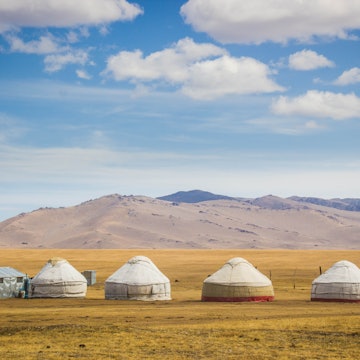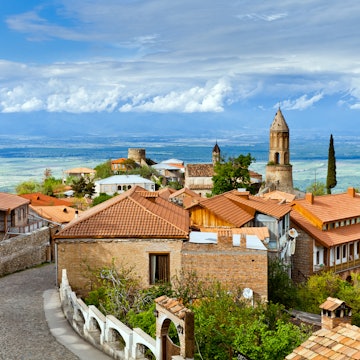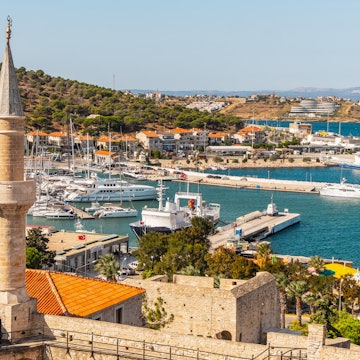

Cafesjian Center for the Arts (aka the Cascade Complex) in Yerevan. Damian Pankowiec/Shutterstock
Located between Türkiye, Georgia and Azerbaijan in the South Caucasus region, Armenia is often overlooked by travelers but there are so many good reasons to put Armenia on your radar. A landlocked country, Armenia offers a unique mix of tradition, stunning landscapes and historic sites that date back millennia. It is home to the world’s oldest winery and boasts the longest nonstop reversible cable car in the world.
A visit to Armenia will have you wowed by the captivating streets and art museums of Yerevan, the jaw-dropping canyon views in Debed, mesmerizing UNESCO-protected monasteries in Alaverdi, and the azure expanse of Lake Sevan.
Here are the 12 best places to visit in Armenia.

1. Yerevan
Best for experiencing the Armenian way of life
Leave your preconceptions at home because Yerevan will almost certainly confound them. This capital city is full of contradictions – top-of-the-line Mercedes sedans share the roads with Ladas so old they should be in museum collections; traditional pandoks (taverns) serving khorovats (barbecue meats) sit next to chic wine or cocktail bars; and street fashions range from Kardashian-chic to babushka with many weird and wonderful variations in between.
Republic Square, with its towering tuff masterpieces, is the beating heart of the “Pink City.” The History Museum of Armenia is a must-visit partly due to its extraordinary collection of Bronze Age artifacts and its 5500-year-old leather shoe (arguably the world’s oldest).
Nearby is the Cafesjian Center for the Arts (aka the Cascade Complex), an arts center with 572 stone steps and 15 small fountains symbolizing Armenia’s 15 provinces. For the best views of the city, ride the escalators and climb up to Victory Park to the mighty 22m (72ft) Mother Armenia Monument.
Planning tip: Yerevan’s city center is walkable with plenty to see. The Soviet-era metro is worth an experience although it’s of limited value for tourists, with just one line and 10 stops.
2. Gyumri
Best for Art Nouveau architecture
Armenia’s second city is its historic and artistic hub. Dating back 2500 years, the town has many stunning 19th-century volcanic tuff buildings, fine stone engravings and often colorful doors. Tragically affected by the devastating 1988 Spitak earthquake, Gyumri has been able to restore most of its architectural glory. Walk through historic streets, visit galleries, meet passionate locals and witness the excitement of a city undergoing its renaissance.
The best example of Gyumri’s Art Nouveau style is the Surp Amenaprkich (All Saviours) cathedral on Vardanants Square with a mixture of black- and apricot-colored tuff and beautiful frescoes inside. Across the square, Surp Astvatsatsin (Holy Mother of God) church buzzes with activity all day long and has paintings and sculptures inside and out. Another noteworthy building is the Museum of National Architecture and Urban Life, which has intricately carved wooden balconies.
Planning tip: The best, and most scenic, way to get from Yerevan to Gyumri is via the express train, which runs only on weekends and takes slightly over two hours.

3. Alaverdi
Best for stunning ancient monasteries
The closest city to Georgia, Alaverdi is a rather unremarkable industrial town at the bottom of the Debed River gorge. However, nearby are two World Heritage-listed medieval monasteries that might just be the most visited in Armenia. Founded in the 10th century, Haghpat has some of the most spectacular views of any of Armenia’s monasteries. Another one is Sanahin, a spectacular religious complex packed with ancient khachkars (carved memorial steles), darkened chapels and medieval study halls, and has a large cemetery behind.
The town is also home to one of the country’s friendliest guesthouses, Iris Bed & Breakfast, whose owners share their wisdom of the Armenian kitchen through masterclasses. Soviet history enthusiasts can visit the Mikoyan Museum, a shrine to notorious Alaverdi-born brothers who shaped the history of the communist empire.
Planning tip: Marshrutky (shared taxis) run up and down Alaverdi’s main road several times a day, as well as up to Sanahin and Haghpat monasteries. Be prepared for long, steep climbs if walking to the monasteries from the city center.
4. Dilijan
Best for scenic mountain hikes
This is perfect hiking territory, even in the height of summer when the weather isn’t too toasty, especially along the red-and-white marked Transcaucasian Trail, which stretches up to Georgia and down to Meghri.
Planning tip: If it’s a rainy day, your best bet is the Dilijan Local Lore Museum and Art Gallery. The entry is pricey, but the museum has an eclectic collection of European and Armenian art from the 16th to 20th centuries as well as an archaeology exhibition downstairs featuring axes and chainmail.

5. Jermuk
Best for careless spa relaxation
A spa day in Jermuk looks a little something like this: wake up in a luxurious resort then eat a healthy breakfast before a meeting with a doctor. The doctor will recommend a line-up of treatments depending on your ailments, ranging from a mineral bath to aromatherapy. After your treatment, have lunch and hang out by the pool or have a silent meander through the calm resort town to Gallery of Water where you may have a sip of mineral water ranging from 30°C to 55°C. Have dinner then repeat for 18 days or longer, depending on how long the doctor recommends.
For the best resort spa, check out the 2019-built Jermuk Hotel & Spa. It has beautiful gardens ideal for post-spa relaxation. Grand Resort Jermuk is another fantastic accommodation choice with its own spa center.
Detour: Jeeps parked behind top-end Grand Resort Jermuk take groups to natural geysers that bubble every five to seven minutes like a mountain Jacuzzi. The hot springs trip takes a couple of hours, depending on how long you want to swim, and is charged per vehicle not per person.
6. Lake Sevan
Best for outdoor enjoyment and intriguing religious architecture
Lake Sevan is the largest lake in the South Caucasus and one of the largest freshwater high-altitude lakes in the world. Its colors and shades can change from royal blue to an enchanting Maldives-like turquoise, which, while exquisite, is partially a sign of toxic algae bloom.
Be sure to visit Sevanavank, one of Armenia’s most popular monasteries which teems with tourists throughout the summer. A pagan temple once occupied the elevated site overlooking the lake, but was replaced by a now-ruined church in 305. The monastery is a worthwhile climb and feels like a pilgrimage with spectacular views over the lake.
Armenia’s most culturally significant site (other than its monasteries, of course) is the breathtaking Noratus Cemetery, which has the largest collection of khachkars in Armenia.
Planning tip: Marshrutky and the summer-only slow train from Yerevan run through the town of Sevan. The only way to get to the eastern side is with your own vehicle or to pay for a private taxi. If hitchhiking or taking a taxi one way, be warned that the eastern side sees little traffic and you may have to wait a while. If driving, there are no gas stations on the east side so make sure your tank is full.
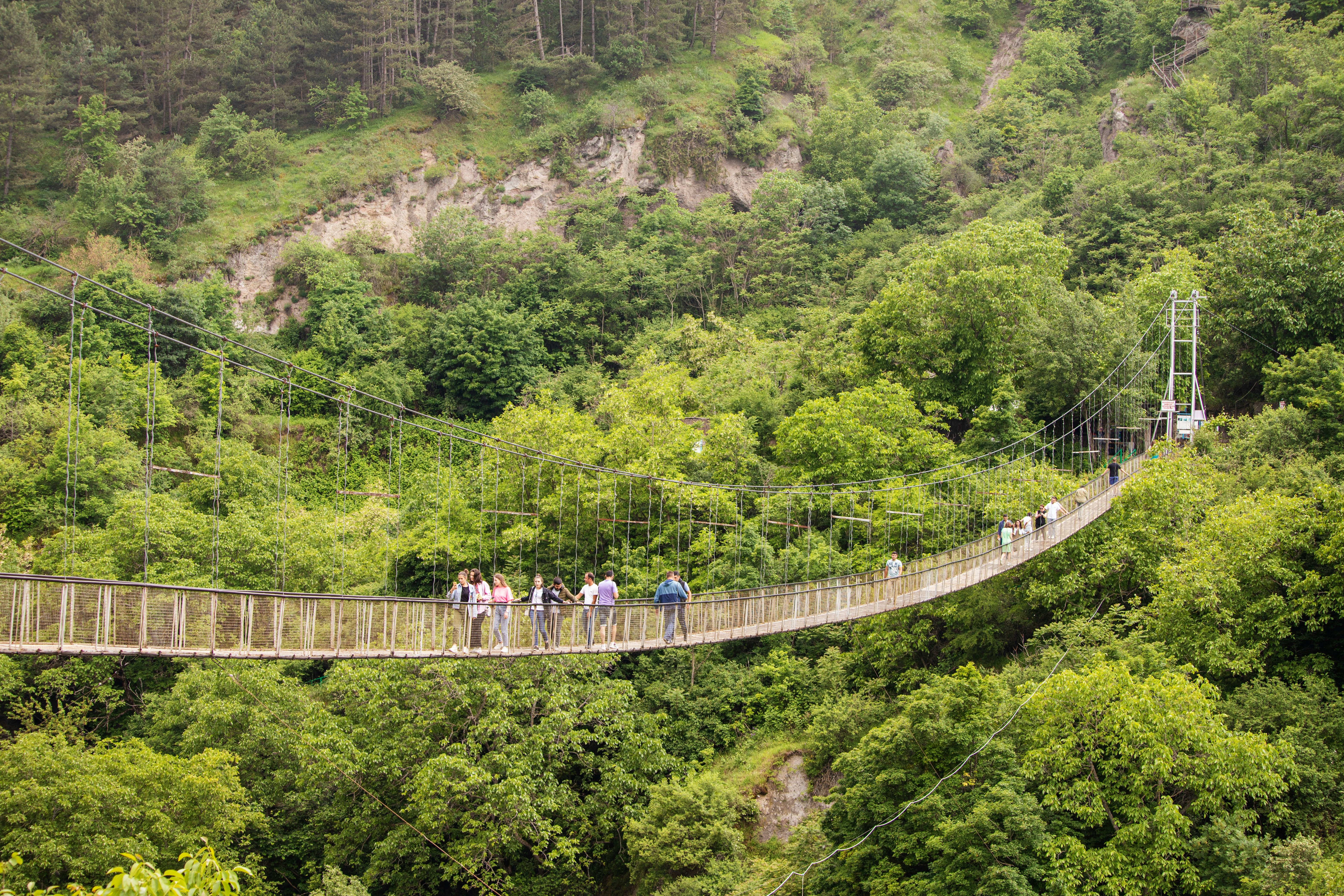
7. Goris
Best for phantasmagoric caves
Besides Gyumri, Goris has the best collection of pre-Soviet 19th-century Armenian architecture. Enchanting stone buildings and intricately carved wooden balconies overlook quiet streets lined with humble, friendly guesthouses. While in Goris, walk around the town’s magical streets, stopping for a photo at its mini–Eiffel Tower (you know you want to), before walking from the town cemetery up to volcanic pinnacle clusters punctuated with cow caves for awesome views.
Less than 15km (9.3 miles) east, don’t miss the cluster of cone-shaped cliffs and caves with old churches accessed via a freaky 160m (524ft) pedestrian suspension bridge.
Planning tip: Every June, the village of Khot near Goris hosts a Sheep Shearing Festival. Local shepherds show off their wool and hold contests to see who is the best shearer in the region. There’s also a fashion show of traditional Armenian clothing and live bands.
8. Areni
Best for wine tastings
The discovery of a 6100-year-old winery in a cave near Areni in 2008 was the equivalent of a loudspeaker announcement declaring that Georgia isn’t the only country in the South Caucasus for wine lovers. Nowadays, there are more than 200 wine producers across Armenia, with most of them in the dry soil around Areni.
Several wineries offer tastings in view of, and beneath, grapevines, paired with juicy local fruits and salty cheeses. And it’s possible to visit the winery cave even as archaeologists continue to excavate. If you were to visit one winery, make it Momik WineCube, which has tastings in the pretty 50-year-old vineyard. Another great choice is Trinity Canyon Winery, with four wine varieties to try.
But Areni would be worth visiting even if it didn’t have a single grape. The area is surrounded by high-contrast sandy cliffs with strange rock formations reminiscent of the US Southwest.
Planning tip: While locals call this the Areni region, the town itself doesn’t have much in the way of good hotels and restaurants. There are more amenities in the nearby town of Yeghegnadzor, which is an excellent base for exploring the south.
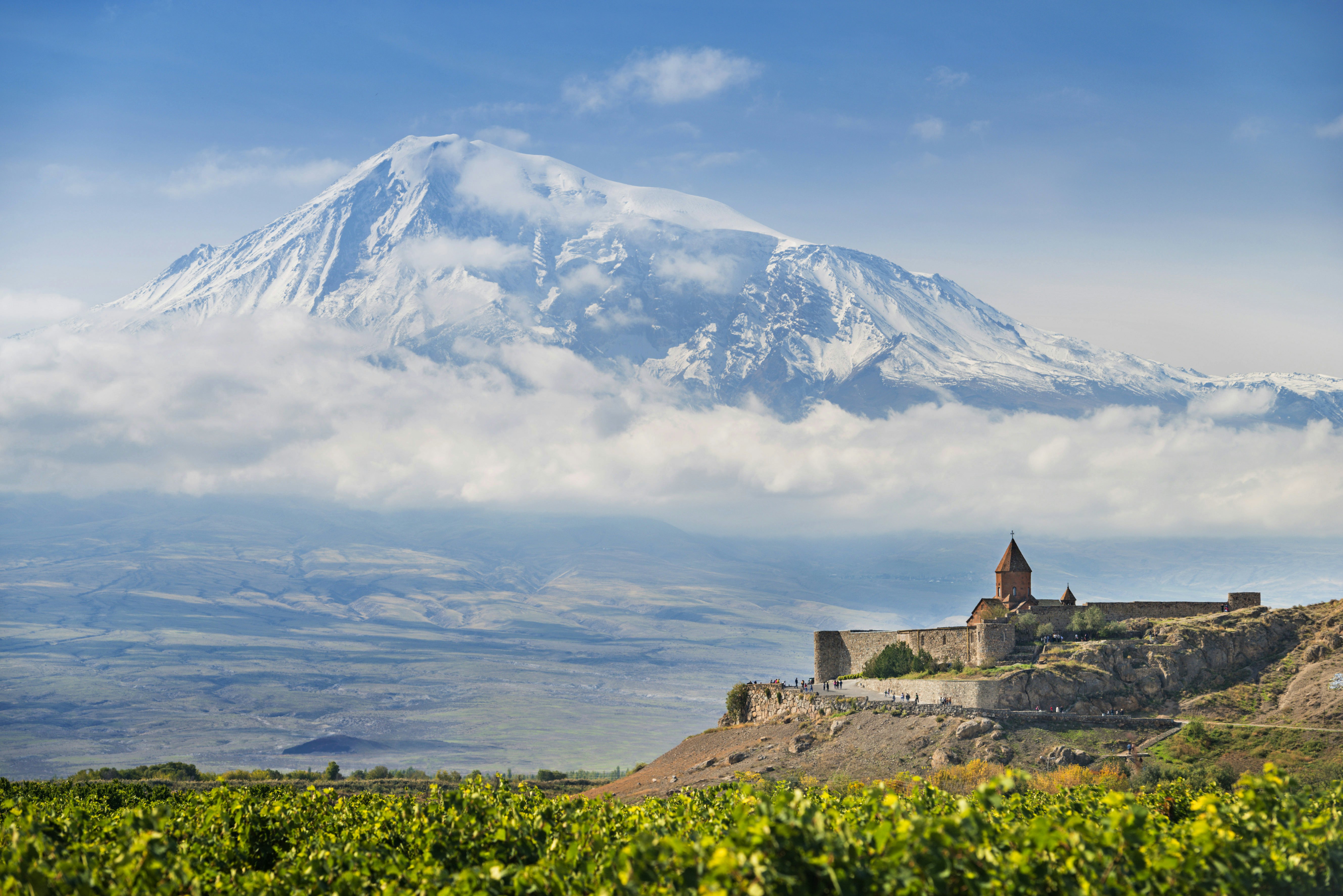
9. Khor Virap Monastery
Best for discovering Armenia’s rich Christian history
Armenia is proud to call itself the world’s first Christian nation. After being converted by Christian apostles, Saint Gregory the Illuminator refused to partake in pagan rites, earning him the wrath of King Tiridates III, who imprisoned the heretic in a pit of snakes for a decade. Gregory’s survival in such hellish conditions so impressed the king that he abandoned his skepticism and converted to Christianity in 301, taking the rest of the country with him.
Experience the history first-hand with a visit to Khor Virap Monastery, where you can climb into the torture pit (now snake-free) and see the beautiful hilltop monastery with views of Mt Ararat. There, you have the picturesque 17th-century Surp Astvatsatsin Church that crowns this fascinating religious complex with an ochre-colored conical dome. Also, check out Artashat, the ruins of the Trdat’s capital founded in the 2nd century BC.
10. Tatev
Best for breathtaking canyon vistas
The tiny rural village of Tatev is perched on a 1600m (5250ft) plateau overlooking the Vorotan River and has jaw-dropping views over its canyon. Get across in style via the Wings of Tatev Aerial Tramway, the longest nonstop reversible cable car in the world. The trip across the gorge is breathtaking, and a recorded narrator explains a bit about what you’re seeing. Once across, follow the crowds to Tatev Monastery, originally founded in the 4th century. Bishops of Syunik built the domed main church, Surp Poghos-Petros (St Paul and St Peter), in the 9th century to house important relics. In the courtyard, look for the 8m (26ft) octagonal pillar topped by a khachkar, which is said to have predicted seismic activity (or the roar of hooves by approaching armies) by shifting.
Major restorations brought Tatev Monastery back to life in 2018, and it’s now one of Armenia’s most popular monasteries, with the faithful lining up to be blessed on most days. Take your time to wander around the complex; there are stairs to climb, tiny doorways to duck through and plenty of pretty views.

11. Noravank
Best for medieval splendor
If you visit just one monastery in Armenia, make it Noravank, founded by Bishop Hovhannes in 1205. Seeing Noravank in the early morning or the late afternoon when the reddish hues of the dramatic cliffs surrounding it are accentuated by the setting sun is a spiritual moment regardless of your beliefs.
The complex includes Armenian architect and sculptor Momik’s masterpiece, Surp Astvatsatsin Church (1339), which has matching steps leading up to a 2nd floor and a circular dome-covered balcony that was rebuilt during extensive renovations in the 1990s. The theory is that Momik made the steps narrow as a sign of faith (walking up is a challenge) and to keep out critters. Unfortunately, visitors can no longer climb up since people kept falling off and the 800-year-old rocks are delicate, but you can (and should) walk inside the main floor.
Out front of the main church is a well you can climb into with a khachkar beneath, as well as an older church, Surp Karapet, which was designed by architect Siranes. Look up at Momik’s magnificent sculpture above the door depicting God holding the head of Adam.
Behind the churches is a set of intricate khachkars and a museum dedicated to Momik. The museum includes photocopies of Momik’s designs from ancient books now protected in Yerevan’s Matenadaran, coins found at Noravank and ingredients used to make healing oils still used during Armenian Apostolic Church ceremonies. There’s limited info, so ask the ticket employee for a tour.
Planning tip: Women with short shorts or skirts are provided with a long cloth to wear at the entrance. Behind the churches is a set of intricate khachkars and a museum dedicated to Momik.
12. Garni Temple and Geghard Monastery
Best for pre-Christian heritage
Less than an hour east of Yerevan are two of Armenia’s most spectacular sites: Garni Temple and Geghard Monastery. Get there with a car tour (driver only) from Republic Square, or with your own vehicle. On the drive, you’ll pass Charent’s Arch, a stone archway built by architect Rafael Israelyan in 1957 to frame the perfect hilltop view of Mt Ararat in the distance.
Next up is Garni Temple, an astonishing 2000-year-old pillared Roman-style temple first built in 77 CE and rebuilt between 1969 and 1975 after it was destroyed by earthquakes and invasions over the years.
In the Garni Gorge below are rock faces made up of basalt columns that look like tubes of an organ, hence the name: Symphony of Stones. Walk the new cobblestone walkway near the Azat Bridge for the best close-ups.
Your tour or drive will finish at the World Heritage-listed Geghard Monastery, founded in the earliest days of Christianity in Armenia. The main stone church, Surp Astvatsatsin, was built in 1215 and houses a chapel with holy spring water that locals line up to touch. Steps left of the entrance lead to a 10m (32ft) passageway with Armenian memorial stone khachkars and a 13th-century burial vault carved directly out of the raw rock. The hills outside the monastery are filled with caves built by monks, and the road leading up is crammed with vendors selling sujukh (walnuts dipped in grape syrup) and gata (sweet pastries).
Planning tip: Vehicles lined up around Yerevan’s Republic Square offer affordable trips to most of the sites beyond Yerevan, though without any guide information. Pay for a pricier tour to get one.
This article was adapted from Lonely Planet's Georgia, Armenia & Azerbaijan guide.








